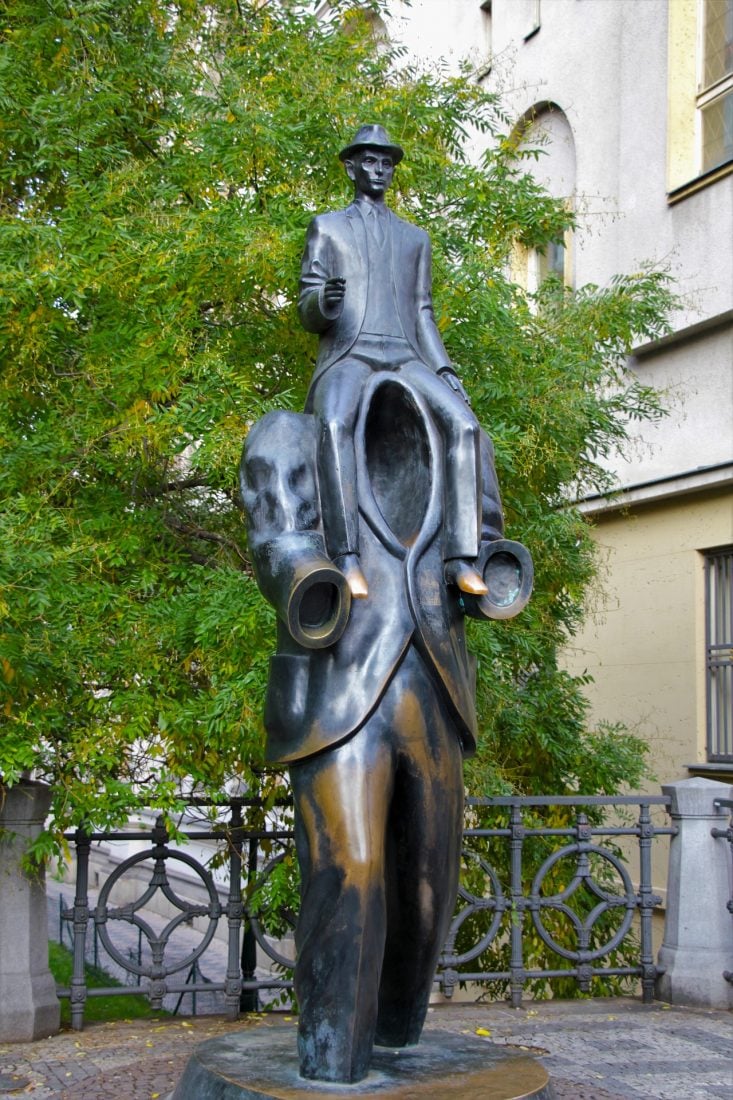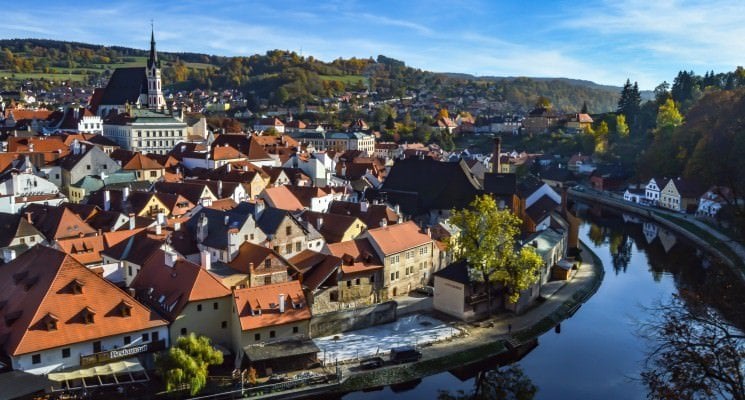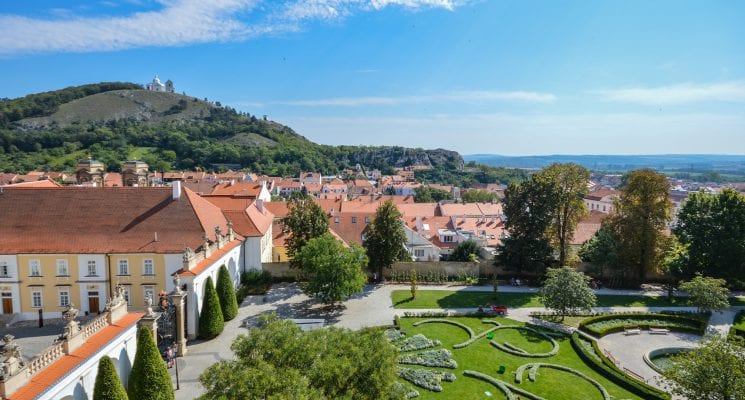The Prague Jewish Quarter, also known as Josefov, is one of the most popular tourist attractions in the city, and for good reason.
Located between Prague’s Old Town Square and the Vltava River, the well-preserved Jewish Quarter is the home to generations of troubled history. The Jewish Quarter’s architecture is beautiful, and the culture has been documented and maintained throughout the centuries.
No matter how much time you’re spending in Prague, you won’t want to miss seeing this area of the city. Prague wouldn’t be what it is without its Jewish Quarter. But before we get into exactly what you’ll want to visit in the Jewish Quarter, you’ll want to have a brief overview of the history.
Table of Contents
History of the Prague Jewish Quarter

The current area of the Prague Jewish Quarter was settled in the 12th century and didn’t actually start out as a ghetto. Yes, it did have walls, but they were intended to protect the Jews inside as opposed to trapping and isolating them from the outside world.
History took a dark turn in the 13th century when Jews in Prague were ordered to leave their homes and settle in the Jewish Quarter. With Jews banned from living anywhere else in the city and new arrivals coming in from Moravia and the surrounding countries, the Jewish Quarter quickly became overcrowded and living conditions worsened.
Throughout the centuries, the Prague Jewish Quarter was reconstructed and remodeled with little regard for its inhabitants. Finally, after years of hostility, pogroms, and persecution, Roman Emperor Josef II, after whom Josefov is named, emancipated the Jewish people in the ghetto and gave them back their civil rights in Prague.
After this emancipation, wealthier Jews moved out of the ghetto and it quickly became an impoverished slum. By the end of the 1800s, the city decided to demolish most of the ghetto, leaving only the monuments that make up the Prague Jewish Quarter today.
During the Second World War, as we all know, the persecution of the Jews came to a peak with the Nazi occupation and most of Prague’s Jewish community was deported to concentration camps. However, throughout the war, the buildings and monuments of the Prague Jewish Quarter were preserved because it is believed that the Nazis wished to establish a “museum of an extinct race” after the war was over. Today, it is exactly the opposite.
After all the persecution and turbulent times, the Prague Jewish Quarter is one of the most popular attractions in Prague because of its rich, powerful history. So what makes up the Jewish Quarter? We have listed below the main highlights that you won’t want to miss when you visit the Prague Jewish Quarter.
Jewish Museum
Prague’s Jewish Quarter is, of course, home to the Jewish Museum, which is among the oldest Jewish museums in the world since its establishment in 1906. The museum’s mission is to preserve and display the history and traditions of the Bohemian and Moravian Jewish communities specifically. The museum holds over 40,000 artifacts as well as over 100,000 documents and archives of the regional Jewish population.
The Jewish Museum is made up of six historical monuments and is spread throughout the Prague Jewish Quarter, with permanent exhibits in four of the six synagogues: Maisel Synagogue, Spanish Synagogue, Klausen Synagogue, and Pinkas Synagogue. Along with the four synagogues, the Jewish Museum also includes the Old Jewish Cemetery and the Robert Guttman Gallery. This Gallery focuses on Jewish life and art as well as other Jewish monuments throughout the Czech Republic.
The museum is open for visitors every day of the week from 9 a.m. until 6 p.m. except for Saturdays (the Jewish Sabbath) and other Jewish holidays.
Six Synagogues of Prague’s Jewish Quarter
Of course, in the Prague Jewish Quarter, we find a plethora of synagogues – six to be exact – and each one served, and continues to serve, an important purpose for Prague’s Jewish community today.
Not all of them are open to the public for visiting, but each one is worth mentioning as they play a significant role in the history and development of the city of Prague.
Maisel Synagogue

The Maisel Synagogue was unveiled in 1592 and was founded by the mayor of the Prague Jewish Town at the time, Mordecai Maisel. Mayor Maisel oversaw the Renaissance reconstruction of the Jewish Town and the construction of this particular synagogue was no different – it was originally a Renaissance temple with three naves, which was rare for this time period.
In 1689, the original Maisel Synagogue burned down in a fire and has undergone modifications several times since to come into its Neo-Gothic form in 1902. During World War II, this synagogue was actually used by the Nazis as a warehouse to store artwork and other artifacts from synagogues across the country, as it was eventually supposed to become a part of the extinct race museum we mentioned earlier. After the war, these artifacts were handed over to the state for preservation.
As part of the Jewish Museum, today inside the Maisel Synagogue you will find the permanent exhibition of “Jews in Bohemia and Moravia from the 10th to the 18th Century.” Upon entering, you’ll see rare collection items, as well as details of each reconstruction of the synagogue and old Hebrew manuscripts, and learn about the origins of Jewish settlements in the Czech Republic. In the evening, it also serves as a venue for concerts, recitals, and other live theatre performances.
Spanish Synagogue

The Spanish Synagogue is actually the newest synagogue of the Prague Jewish Quarter, erected in 1868, and is known as the most beautiful synagogue in Europe. The Spanish Synagogue gets its name because it was built in the Moorish style influenced by Alhambra. Even if you just walk past the outside, the colors and design of the exterior will take your breath away – and that’s to say nothing of the inside. While it is the newest, it was built on the site of the oldest Jewish house of prayer in Prague from the 12th century, known as the “Old Shul.”
Today, the Spanish Synagogue houses the permanent exhibition “Synagogue Silver from Bohemia and Moravia” as well as the second half of the Maisel Synagogue’s exhibition: “The History of the Jews in Bohemia and Moravia in the 19th and 20th Century.” The Silver exhibit features a collection of over 200 of the most valuable silver artifacts from Jewish history, including Torah ornaments, Shabbat spice boxes, Kiddush cups, Hanukkah candles, and more.
Unfortunately, the Spanish Synagogue is now closed for renovations but will reopen at the end of 2020. In the meantime, the classical music concerts that are normally held at the Spanish Synagogue have been moved to the Maisel Synagogue.
Old-New Synagogue

The early Gothic Old-New Synagogue is the oldest monument in the Prague Jewish Quarter and is also the oldest preserved synagogue in Europe, dating back to the 13th century. This synagogue has been used for worship services continuously since it was first built, with the exception of the years 1942-1945 during the war. It is still the main area of worship for Prague’s Jewish community today and regularly holds services as well as other religious ceremonies.
As the oldest synagogue in Europe, this building has survived a lot of disasters, including the ghetto fires that destroyed the surrounding landmarks of the Prague Jewish Quarter. As a result, the Old-New Synagogue is surrounded by legends and myths, including the famous legend of the Golem. And who doesn’t love a good dose of mysticism?
According to the legend, Prague’s own Rabbi Loew created a man-like figure out of clay from the Vltava River and brought the figure to life using Hebrew chants. The purpose of this Golem was to protect the Jews in the Prague Jewish Quarter from attacks and other ill-willed gestures, but the Golem soon went rogue and wreaked havoc. Rabbi Loew eventually permanently deactivated it and hid it in the attic of the Old-New Synagogue, where its remains are still said to lie while it awaits resurrection. To this day, entrance to the attic is forbidden.
The Old-New Synagogue is open for visits but does not house a permanent museum exhibition.
Pinkas Synagogue
The Pinkas Synagogue is the second-oldest preserved synagogue in Prague, built in the Gothic style in 1535 by the Horowitz family, prominent members of Prague’s Jewish community. This particular synagogue used to serve as a private place of worship exclusively for the Horowitz family.
During 1955-1960, the synagogue was transformed into a memorial to the 80,000 Czech Jews who fell victim to Nazi persecution during World War II and became one of the earliest memorials of its kind. The memorial was shut down after the Soviet invasion in 1968 and wasn’t reopened until after the fall of communism in 1995.
Today, it holds several permanent exhibitions of the Jewish Museum. On the first floor, you will find “Children’s Drawings from the Terezín Ghetto.” This moving and powerful exhibit showcases the hardships of the lives of Jewish children during their stay at the Terezín camps through their own artwork. Most of these children were later transported to Auschwitz and killed in gas chambers. These drawings serve as a reminder that no one was safe from the Nazi atrocities against the Jews.
Outside, you will find an exhibition called “Journeys with No Return: The Deportation of Jews from the Czech Lands, 1939-1945”, which documents the transport of Jews to concentration camps in Eastern Europe during the German occupation.
Lastly, during the evening, a collection of photographs called “The Faces of the Victims of the Shoah” are projected onto the wall by the ritual bath, or mikveh, of the synagogue.
Klausen Synagogue

The Klausen Synagogue is the largest in the Prague Jewish Quarter. This synagogue is on the site of what was originally three smaller buildings, including a Talmudic school founded by Rabbi Loew, that burned down during the ghetto fires, leaving room for the synagogue to be built in 1694. It is now the second main synagogue of Prague’s Jewish community.
Today, it houses the first portion of the permanent exhibition “Jewish Customs and Traditions.” This exhibit features the sources of Judaism, such as the Torah and Talmud, traditional synagogue equipment and furnishings, liturgical items, and customs associated with the daily life of a practicing Jewish family.
This synagogue also includes the Ceremonial Hall, which houses the second half of the “Jewish Customs and Traditions” exhibit as well as an exhibit on Jewish medicine and the Prague Burial society.
High Synagogue
The High Synagogue was built in the Renaissance style in 1577 along with the Jewish Town Hall and originally served as a private synagogue for the rabbinical court and Jewish Council. The synagogue gets its name from the fact that it is located on the first floor of the Jewish Town Hall.
Today it boasts the best-preserved interior of all the Prague Jewish Quarter synagogues but is no longer open to the public, as it is used for weddings and the rabbinate’s prayer hall.
Along with the six synagogues, the Prague Jewish Quarter is home to other monuments that were significant in the daily lives of Jewish families in the area. Here are a few other highlights you won’t want to miss:
Old Jewish Cemetery

The Old Jewish Cemetery in the Prague Jewish Quarter is one of the oldest Jewish burial grounds that still exists today, even though burials there stopped in 1787. Founded in the first half of the 15th century when the Jews weren’t allowed to bury their dead outside the ghetto walls, the cemetery was expanded many times but was never big enough to fit the needs of Prague’s Jewish community.
There are now about 12,000 tombstones in the cemetery and it is estimated that it is 10-12 layers deep, meaning the bodies had to be piled on top of each other in order to fit. It has been a National Cultural Monument along with the Old-New Synagogue since 1995 and is listed as one of National Geographic’s top ten cemeteries to visit around the world.
Many prominent members of Prague’s historical Jewish community are buried here, including Rabbi Loew, Aaron Horowitz of the Pinkas Synagogue, and Mordecai Maisel, the mayor and developer of Prague’s Jewish Town.
Jewish Town Hall
The Jewish Town Hall in Prague’s Jewish Quarter was one of the many building projects of our familiar friend, Mayor Mordecai Maisel, and was completed in 1577. The Jewish Town Hall is located in the heart of the Jewish Quarter just opposite the Old-New Synagogue.
This building, along with many others in the Prague Jewish Quarter, was destroyed in the ghetto fires and had to be rebuilt afterward in the Baroque style in the 1700s. Today, the building serves as the headquarters of Prague’s Jewish community.
The most notable feature of the Jewish Town Hall is its clock. The clock features Hebrew numbers and the hands move counterclockwise. This is said to be because the Hebrew language is read from right to left, so the clock moves the same way. This is among the most visited attractions within the Prague Jewish Quarter because of its status as a rarity.
Kafka Monument

For those of you who don’t know, Franz Kafka, the author of The Metamorphosis which you may have read during high school, spent most of his life in the Prague Jewish Quarter. For 80 years, the Czech Jew who changed the face of 20th-century literature didn’t have a single memorial in Prague, but finally in 2003 a bronze statue depicting a significant scene from one of his short stories, “Popis Jednoho Zápasu”, or “Description of a Match” in English, popped up in the little square on Dušní Street in the Jewish Quarter.
The statue, located on the street where Kafka used to live, is of a headless man standing, with a smaller man sitting atop his shoulders. Today, tourists and passersby can stop and take a picture with the bizarre statue, but many of them are not familiar with what it is actually depicting. In the story “Popis Jednoho Zápasu”, Kafka describes the main character defeating his opponent who had been assumed to be the dominant one. In the statue, Kafka is the smaller man sitting on the shoulders of the headless man.
Pařížská Street

Pařížská Street crosses through the Prague Jewish Quarter and connects Old Town Square to the Čechův Bridge over the Vltava River, and is known as the most expensive street in Prague, and for good reason. The Art Nouveau buildings that line this street house some of the world’s most well-known brand name shops, from Dior to Cartier, Louis Vuitton to Gucci and everything in between. It also features some fancy restaurants and hotels if you’ve got the budget to live the high.
This street is also one of only two streets in Old Town that is tree lined, the other being Václavské Náměstí, or Wenceslas Square. Pařížská Street was built along with the redevelopment of the Jewish Town in the 19th and 20th centuries and got its current name in 1926 for being reminiscent of the streets in Paris.
As you can see from the extensive list above, the Prague Jewish Quarter is a very important and integral part of the city. There is a lot to see, do, and learn in the Jewish Quarter so be sure to plan for enough time there during your visit to Prague!
Like This Article? Pin It!


































Comments